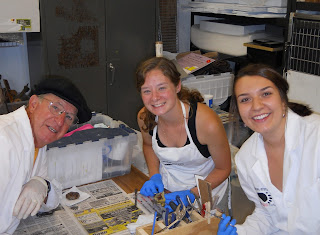Natural Object to Museum Specimen
Boy Scouts took over the Museum this past weekend, ready in their khaki attire and eager to demonstrate their outdoor knowledge. While "tour guide" hadn't shown up in my job description, I briefly took on that role to introduce the boys to how museum specimens come about. A great deal of behind-the-scenes work goes into building a museum's collection. Methodical steps are taken from object intake to exhibition. The boys followed me to a few stops in the building, where I shared these steps with them and will do so now for my readers.
The first encounter with my two favorite geodes in the collection began when our docent JoAnn brought me those heavy rock formations in a simple cloth bag. Dirt still lined each surface indentation and no doubt some tiny critters lived there too. I asked her a few questions about how she found the geodes and brought them to my work space. Another time a tiny, unmistakable boreal owl arrived from the Washburn area. There was no blood or visible sign of its demise, and I admired the bird as it laid lifeless in a shoebox before I also brought it to the back work space.
As with the geode and owl, objects do not immediately gain access into the collection storage room. Rather, most take a trip into the prized Salvage Freezer. In a restricted back room, this chest freezer may hold many salvaged animals, sealed in zip lock bags to keep their carcass from rotting. Objects like a dirty geode also take a trip to the freezer as a preventative measure against pests that could be hiding in crevasses. Pests are a scourge of museums, and we go through many measures to keep them from collectively destroying specimens.
 |
| Specimen preparation may include taxidermy done by staff. |
When the time comes to remove objects from the freezer, our Curator or Collections Monitor prepares to clean and beautify them for eventual display. Geology items get a thorough scrub, animals are preserved through taxidermy, plants are pressed, insects pinned, and so forth. Sometimes this step may take a few days or even require the expertise of someone outside of our museum. Just recently, I transported a frozen peregrine falcon to a local taxidermist who will preserve and mount the bird for us, positioning the falcon to look as natural as possible. While plants become flattened or animals given lifelike dimension, a Curator thinks about documentation.
Recordkeeping is imperative. Any information kept on museum specimens can help to give them meaning--whether it be where the specimen was originally found or even its size. Objects are assigned specific numbers corresponding to when they arrived and an entire catalog worksheet is dedicated to describing them. For example, the first object received this year would have become object number 2018.01. One should ideally be able to match up a catalog record with an object simply based on the description provided on the catalog sheet. The object number and its record will remain throughout a specimen's life at the museum.
 |
| Archival images add to a specimen's thorough description in records. |
Additionally, all of an object's information is stored in a computer database. Digital photos are taken, and once all paperwork is filed, a natural object becomes a museum specimen. Accuracy is paramount. Curators, and in larger institutions, registrars, collection managers, and other staff follow specific procedures to best document their specimens. Likewise, preservation requires specific procedures and materials. Pigma Micron pens are invaluable for labeling; latex gloves are restocked frequently.
Specimen eventually find a home in a collection storage room and periodically rotate onto display. More paperwork may accumulate in the records as specimens are assessed, inventoried, moved, and occasionally sold or donated if they lose value to the museum.
Much of this I did not know before becoming Curator. A pile of books and binders help to point me in the right direction as I prepare objects for the Museum, and I continually discover more as I read or discuss procedure with others. As the Boy Scout group took a small peek at our operation that Saturday, I considered all of the work that was done over the years to develop our collection into what it is today.